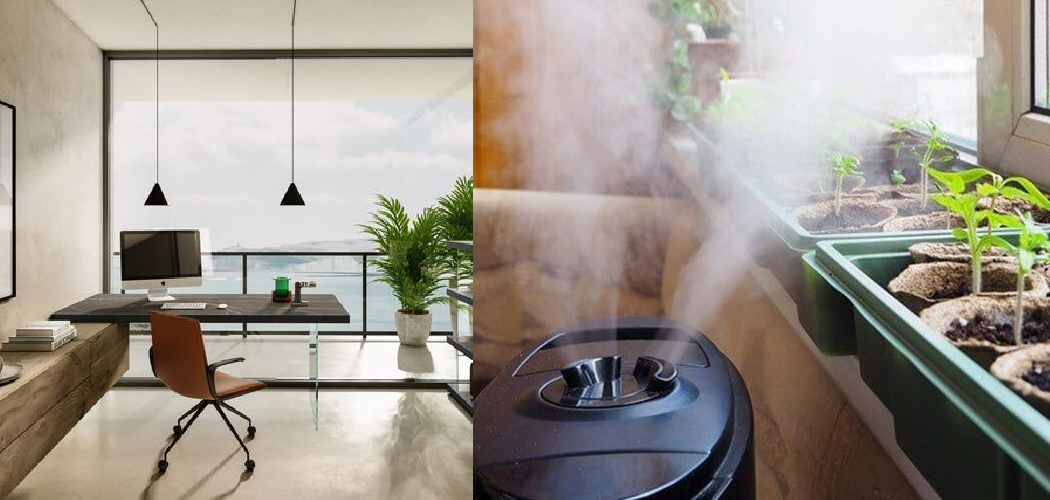If you ever feel like your office is too dry. You’re not alone. Many people find their offices dry and uncomfortable, leading to several health problems. Luckily, there are some things you can do to increase the humidity in your office. In this article, we’ll explore how to increase humidity in office. Read on for more!

The office is the place where we spend most of our time. Therefore, it’s essential to have a comfortable working environment, and for many people, that means having the right humidity level. Unfortunately, not all office buildings are created equal when it comes to humidity. It’s not uncommon for office buildings to have dry air, which can cause various health problems. If you find yourself in a dry office, you can do a few things to increase the humidity. We’ll explore some of those options below.
What’s the Ideal Humidity Level for an Office?
The ideal humidity level for an office depends on several factors, including the type of business, the climate, and the employees’ preferences. However, it is advisable to maintain relative humidity between 30 and 50 percent. Too much humidity can lead to mold and mildew growth, while too little can cause respiratory problems and static electricity.
The best way to achieve the ideal humidity level is to use a humidifier or dehumidifier, depending on the current conditions. These devices can help regulate the air quality in an office, making it more comfortable for everyone. In addition, it is important to ventilate the office regularly to prevent the build-up of moisture.
Signs of Low Humidity in the Office
Dry eyes, skin, and lips are common signs that the air in your office is too dry. Other less common symptoms may include:
- Sinus or respiratory problems
- Headaches
- Fatigue
- Difficulty concentrating

If you suspect that low humidity might be to blame for any of these issues, there are a few things you can do to increase the moisture in your office space.
Why Is It Important to Maintain a Constant Humidity?
Although many people think of humidity as simply the amount of moisture in the air, it measures how much water vapor is present in the air. Water vapor is invisible, but it plays an important role in our everyday lives. For example, when the air is humid, it feels warmer than when it is dry because moist air can hold more heat.
In addition, humidity plays a vital role in regulating the weather and climate. When the air is humid, it prevents heat from escaping into the atmosphere, leading to warmer temperatures. Conversely, heat escapes more efficiently when the air is dry, resulting in cooler temperatures. Therefore, humidity plays a vital role in maintaining Earth’s temperature.
Humidity is also vital for human health. When the air is too dry, it can cause respiratory problems such as nosebleeds, coughing, and difficulty breathing. Dry air can also aggravate conditions like asthma and allergies. On the other hand, excessively humid air can lead to mold growth and musty odors. Therefore, it is crucial to maintain a comfortable humidity level in your home or office.
A Detailed Guide on How to Increase Humidity in Office
Option 1: Drink Water
Water will help raise the humidity in your office by evaporating into the air and increasing the moisture content. When the relative humidity in your office is too low, it can cause several problems, such as dry skin, static electricity, and respiratory issues. Drinking water will help increase the humidity, but it will also keep you hydrated and healthy.

There is no set amount of water that you need to drink to increase the humidity in your office, but aim for 8-10 glasses per day. Of course, if you feel particularly dry or uncomfortable, you can always drink more.
Option 2: Get Some Indoor Plants
Plants take water through their roots and then release it into the air through their leaves. This process of transpiration increases the moisture in the air around the plant.
Many different types of plants can help increase humidity, but some are better than others. Some of the best plants for increasing humidity include:
- Boston ferns
- Snake plants
- Peace lilies
- Bamboo palm
- Areca palm
- Rubber tree plant
Place one or more of these plants near your desk or in another conspicuous spot in your office, and enjoy the extra moisture they bring to the air. Just be sure to give them enough sunlight (aloe vera and snake plants can tolerate low light levels) and water (bamboo palm likes it on the drier side) to keep them healthy and happy.
Option 3: Use a Humidifier
A humidifier is a machine that increases the humidity, or water vapor, in the air. Many types of humidifiers are available to purchase, ranging from small tabletop models to larger free-standing units. Some humidifiers require a power source, such as an electrical outlet, while others may run on batteries.
If you suffer from dry eyes, itchy skin or other issues caused by low humidity, using a humidifier in your office can help alleviate those problems. You may also find that you sleep better and have less sinus congestion when the air is more humid.
There are a few different types of humidifiers available on the market, so you’ll need to decide which one is right for your needs. For example, some use cool mist, while others use warm mist. There are also ultrasonic humidifiers, which create a fine mist using vibrations.
Set it up in your office once you’ve chosen a humidifier and turn it on. You may need to experiment with the settings to find the perfect humidity level for your space. For example, it would help to aim for 30-50% relative humidity.

If you live in a dry climate or heat your office with forced air, you may need to use a humidifier daily to maintain the desired humidity level. Otherwise, you may only need to use it occasionally. Be sure to clean your humidifier regularly to prevent the growth of mold and bacteria.
Option 4: Turn Off Printers and Other Machines
The machines in your office, such as printers and fans, can be contributing to the low humidity levels. They tend to release hot air, which can further dry out the air around them.
Try to turn off these machines when you’re not using them. You may also want to consider moving them away from any vents in the room so that they’re not directly exposed to dry air.
Option 5: Place Bowls of Water Around the Room
One way to increase the humidity in your office is to place bowls of water around the room. The water will evaporate into the air and help to increase the overall humidity level. This is an excellent option if you have a large office or want to raise the humidity level quickly. Just check the water levels periodically and add more as needed.
Option 6: Take Care of Dry Eyes
If you work in an office, you suffer from dry eyes. The good news is that you can do a few things to help increase the moisture in your eyes and relieve the discomfort.
First, make sure to blink often while working at the computer. This will help keep your eyes lubricated. You can also try using artificial tears or eye drops to help moisturize your eyes.
It’s also essential to keep the air around you moist. You can do this by using a humidifier in your office. Just be sure to clean it often to prevent the growth of mold and mildew.
Finally, if you suffer from chronic dry eyes, you may want to see an eye doctor. They can prescribe medication or suggest other treatments to help relieve your symptoms.
Option 7: Prevent Air Leakage
It might seem counterintuitive, but one of the best ways to increase humidity in your office is to prevent air leakage. By sealing up any cracks or gaps in your office space, you can help to trap moisture in the air and make it more difficult for the humidifier to do its job. In addition, preventing air leakage will also help reduce drafts and keep your office more comfortable overall. There are several ways that you can seal up cracks and gaps in your office, such as:

- Use weatherstripping around doors and windows
- Caulk any cracks or gaps in walls, floors, or ceilings
- Install door sweeps on all entry doors
- Replace worn or damaged window seals
By taking these steps, you can help to increase the humidity in your office and make it more comfortable for everyone. In addition, these options will help in how to increase humidity in office.
6 Other Ways to Increase Office’s Humidity
- Use a humidifier: A humidifier is an excellent tool for increasing the humidity level in an office. It adds moisture to the air, helping to balance out the dry air from your heating and air conditioning systems. Purchase a humidifier that is sized for your office space and follow the manufacturer’s instructions for use.
- Add plants: Plants are natural humidifiers. They release moisture into the air through a process called transpiration. Adding a few plants to your office can help to increase the humidity level while also improving air quality and reducing stress.
- Keep a bowl of water out: Simply placing a bowl of water on your desk can help increase your office’s humidity level. As the water evaporates, it releases moisture into the air. Try adding a few drops of essential oils to the water for a pleasant scent.
- Hang wet towels: Hanging wet towels near your office’s heating and air conditioning vents can help to increase humidity levels. The airflow from the vents will cause the towels to dry slowly, releasing moisture into the air.
- Keep doors open: Keeping doors open can help to circulate air throughout your office, which can help to increase humidity levels. This is particularly effective in smaller offices or those that are poorly ventilated.
- Use a spray bottle: Using a spray bottle to mist water into the air can help to increase humidity levels. This is particularly effective in larger offices or those with high ceilings. Simply fill a spray bottle with water and mist the air periodically throughout the day.
Does Heating Increase Humidity?
The air around us is always full of water vapor, but we only notice it when the air is saturated or “humid.” The amount of water vapor that air can hold depends on its temperature. Cold air can’t hold as much water vapor as warm air. So your breath fogged up on a cold winter day, but not on a hot summer day. When saturation occurs, the extra water vapor condenses into tiny liquid water droplets, visible as fog or clouds.
The term “relative humidity” expresses the actual amount of water vapor in the air as a percentage of the amount of water vapor the air could hold if it were saturated. For example, if the air holds half the amount of wate vapor it could hold if it were saturated, then the relative humidity is 50%.
The RH of air generally increases as the temperature d1ecreases. That’s because cold air can’t hold as much water vapor as warm air. However1, there are other ways to increase the RH of air, even when the temperature is constant.
You Can Check it Out to Sit in an Office Chair With Back Pain
Conclusion
If you are looking for a way to increase humidity in the office, there are several things you can do. For example, you can install a humidifier, ensure your plants are healthy and watered, or use essential oils. We hope you find this article on how to increase humidity in office useful.

